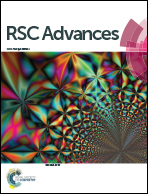Piperazinium-mediated crosslinked polyimide-polydimethylsiloxane (PI-PDMS) copolymer membranes: the effect of PDMS content on CO2 separation†
Abstract
We synthesized copolymers consisting mostly of physically stable rigid polyimide (PI) and a low content of highly permeable rubbery polydimethylsiloxane (PDMS), that were crosslinked by CO2-philic ionic piperazinium groups attached to the side chains of the copolymers. These crosslinked copolymers (xPI-PDMSs) were fashioned into membranes that showed very high levels of thermochemical stability and excellent CO2 separation performance (PCO2 of 799 Barrer and CO2/N2 permselectivity of 15.7). The inclusion of the piperazinium groups not only endowed these xPI-PDMS membranes with increased selectivity for CO2, but also good resistance to CO2 plasticization. The effect of PDMS content on morphology and CO2 separation properties of xPI-PDMS was also investigated.



 Please wait while we load your content...
Please wait while we load your content...